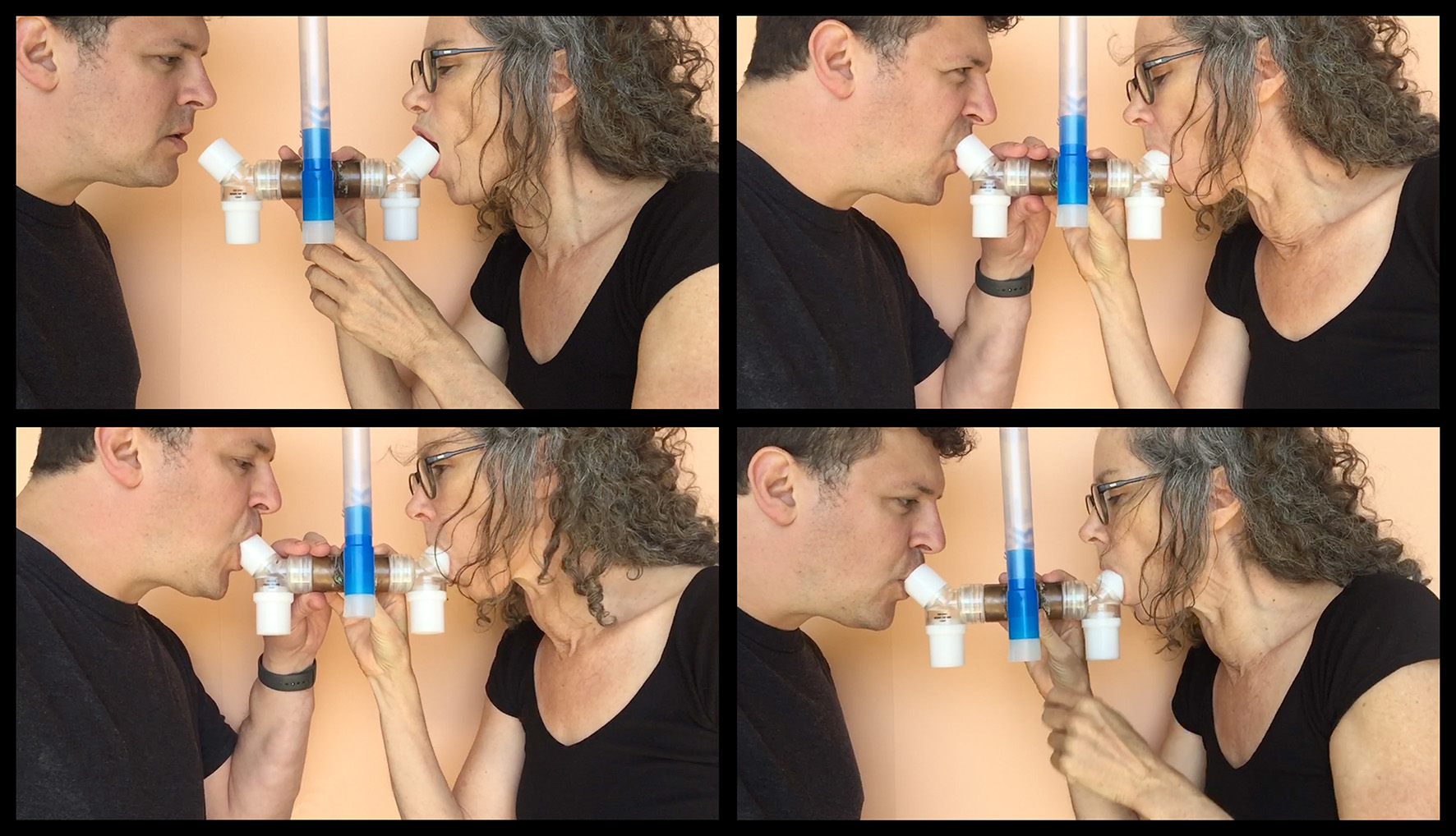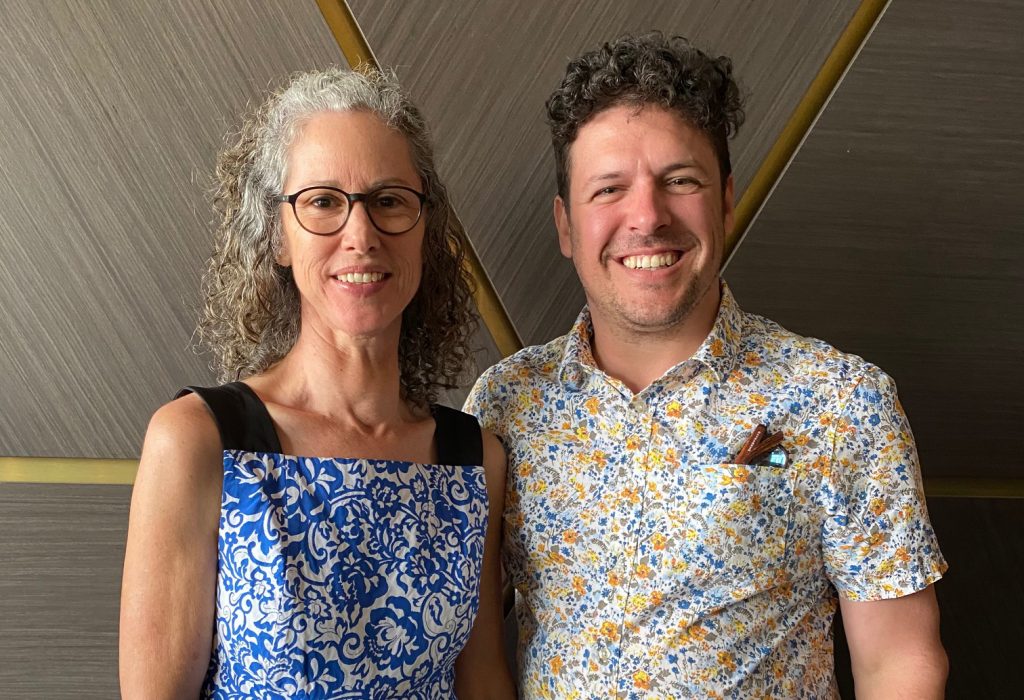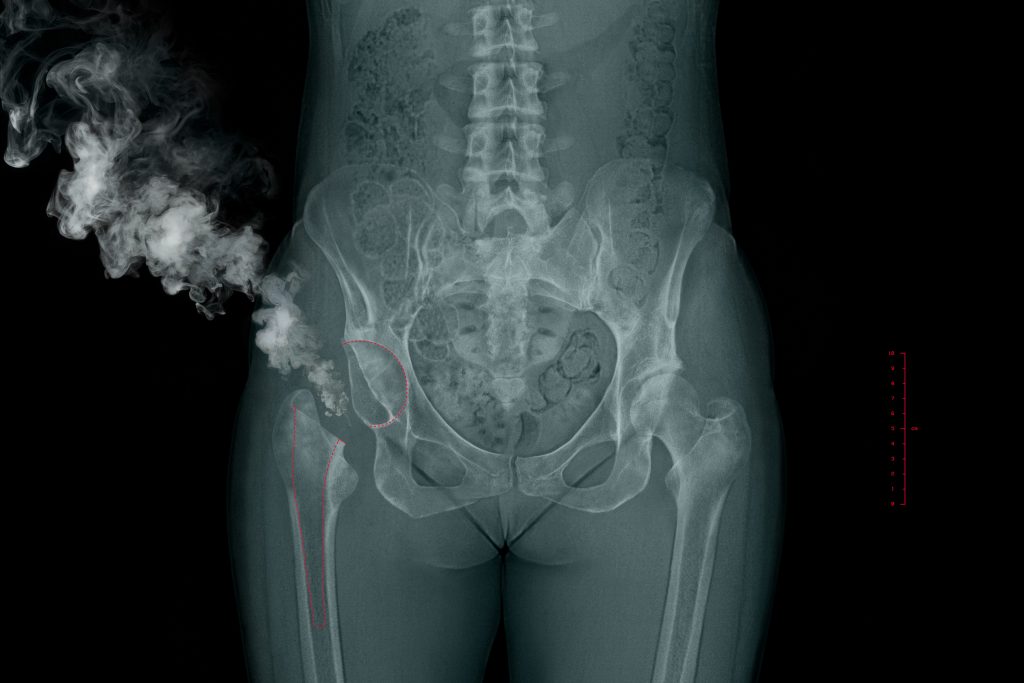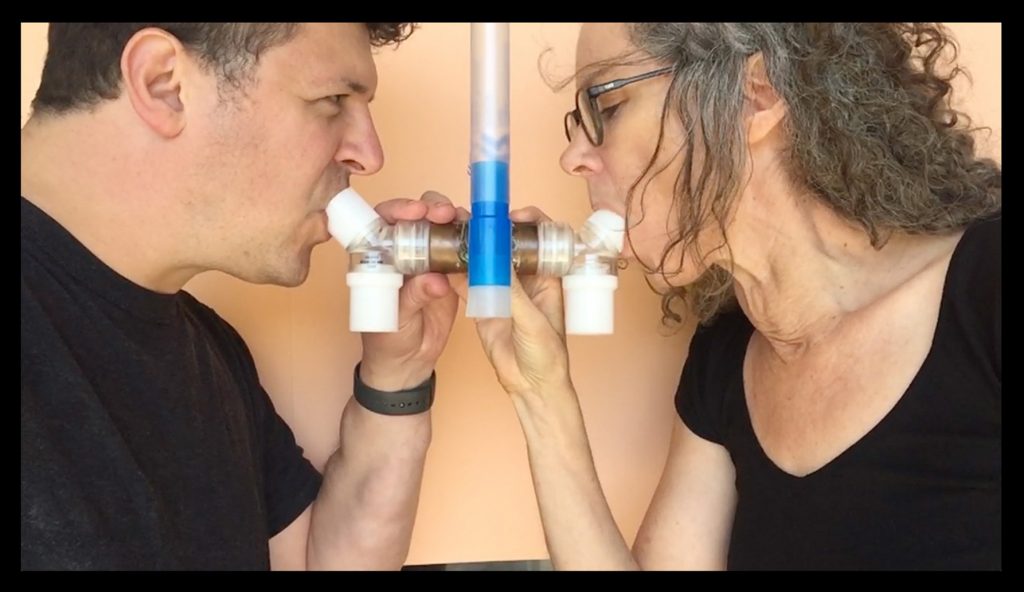
Dr Helen Pynor and Dr Jimmy Breen, documentation, testing the collection of a shared breath sample using the R-tube device. Exhaled DNA will later be extracted and sequenced. 2021. Image courtesy of the artist. ANAT SAHMRI residency, Adelaide, 2021.
Dr Naomi Hunter in conversation with ANAT SAHMRI resident Dr Helen Pynor & Dr Jimmy Breen
Radio Adelaide’s Festival City Producer, Dr Naomi Hunter talked to ANAT SAHMRI resident Dr Helen Pynor and Dr Jimmy Breen, leader of the SAHMRI Bioinformatics Platform about their collaborative research around the status of DNA material once it leaves its originating body.
Hear the whole conversation… or read an extract and transcript below.
DR HUNTER: Welcome back and you are listening to Festival City on 101.5. And today we have another amazing art + science collaboration. And in the studio today we have Dr Helen Pynor and Dr Jimmy Breen. So welcome to the show. What I would love to give our audience a little sense of is what you do as individuals and then how you’ve come together in this collaboration and I might actually start with Helen. Helen, tell us a little bit of a lightning exposé of your work.
DR PYNOR: So I’m a visual artist but I actually have a background in science. So I’ve had a longstanding deep fascination in science and my practice has focused on in recent years, philosophically ambiguous zones like the life/death boundary, organ transplantation, the relationship between prosthetics and living tissue, and things like what happens to tissue once it leaves the body. Like, is it still alive; what’s its status? And I work across a whole range of mediums from installation to video, photography, sculpture, but also collaborating with scientists is a big part of my practice.
MS CHRISTOFI: So this is a pretty morbid topic in a way, in the areas that you’ve covered. Where did the interest stem from initially?
DR PYNOR: Yeah, good question. We could delve deep into my dark psychology for the answer to that [laughs]. What I find, I mean, there is a morbid aspect to it definitely. But I think it’s driven much more by a sense of curiosity and a life affirming sense of, I mean, the life/death boundary, when you start to look at that you realise that life just extends out everywhere into places that we don’t normally think about. And, ultimately, I find these questions very life affirming, actually.
DR HUNTER: I was going to say, I actually am always fascinated by all things human body, biology. So I find it really interesting, but there is that idea of the abject when people see bodily like objects and they’re not within the bounds of a body, then sometimes people can freak out a little bit.
DR PYNOR: Yeah, there’s often a bit of an irk factor with my practice, but often, I don’t really necessarily consciously calibrate it this way, but it’s often I think calibrated at the edge of something sort of irky and something fascinating or beautiful, that draws people in as well as potentially repulsing them.

Dr Helen Pynor and Dr Jimmy Breen. Photograph Jenn Brazier.
DR PYNOR: And if I get that edge right, then I feel like I’ve kind of succeeded.
DR HUNTER: That push/pull.
DR PYNOR: Absolutely.
DR HUNTER: I don’t know about you, I love some repulsion [laughs]. Thank you so much, Helen. Now, Jimmy. I said at the beginning of the interview when I read his bio that he was going to have to explain what the name of the unit at SAHMRI is that you are the leader of.
DR BREEN: Yeah. So the Bioinformatics Core Facility.
MS CHRISTOFI: Yeah, tell us, what is that?
DR BREEN: A bioinformatician is probably best described as someone who just analyses biological information. So it could be information about demography, like, sex, age, all that sort of stuff. Kind of what we describe as health analytics but my specialty specifically is genome sequencing. So I do the analysis of the raw – just putting the DNA into the sequencer and really the signal that comes out, and then really analysing that and putting it into a genome as such, or a profile of a person. It’s probably, I guess, Helen was describing the birth/death scenario; we’ve kind of just got the death, in terms of that, right [laughs].
DR HUNTER: So, Helen, I know that you have had quite an extensive creative career and there’s one particular project that I would love – because I feel like it relates to this project – where you actually had a piece of bone removed because it had to be, but then you went on to use that in your practice. So we often have unintentional extended body, I’ll call it, where you’ve lost hair and saliva, skin cells are floating away at all times, but this was intentionally removed and then you requested to actually have that given back to you. Do you want to tell us a little bit about that project that resulted from that?
DR PYNOR: That was a commission from Experimenta and, yes, I had surgery on my hip and I had the head of my femur removed and I was really keen to work with that bone material and to incorporate it into bone china work. So bone china, as you might know, is made up of about 50% animal bone. So it was like an early, well, not early compared to porcelain, but it was a method to try and create porcelain-like ceramics developed in England. And I found it really fascinating the idea that this porcelain or this bone china was full of animal material and that my bone could be part of that ceramic. And also that I could take it through all of those transformations that are involved in making bone china which are really alchemical and really beautiful. But it wasn’t straightforward to get a hold of the bone, which people are always surprised to learn that we don’t get automatic access to tissue that’s excised from our own body. It’s, like, well, surely we own that. And what I found, there’s a Melbourne-based artist, J.J. Hastings, who had researched all of the policies around keeping your own tissue. What she found was really surprising, that actually the policies support you to keep your tissue if you want it, but the surgeons and medical practitioners are often not aware of that, so they often just reflexively say ‘no’. So I was able to pull out these policies when I made my request.

Capacity 2 (crop) from the Habitation series, Helen Pynor, 2020. Archival pigment print, lightbox. 120 x 67.5 cm. Edition of 1 + 1AP
Capacity has been supported by the City of Joondalup, Western Australia. Habitation, a 2021 Experimenta Commission.
DR HUNTER: Obviously in advance, of the actual surgery.
DR PYNOR: [Laughs] Absolutely. Six months out.
DR HUNTER: A question that I have is as human beings, we have a lot of our body that we can see and then a lot of our body that we can’t see. What was it like to actually receive that piece of bone knowing that it had been inside you and now was this separate object? Did it have more sentimental value to you than say if you were using another person’s bone or an animal bone?
DR PYNOR: Yeah. It did. It felt quite sacred and quite precious and it was also a hip that worked really hard to try and work all of my life, because I was born with this abnormality on one side. And that hip had worked so hard to make things work in really difficult conditions. So I felt this incredible gratitude for this bit of bone and that endeared it to me. And just knowing that it had come out of my own body, it’s been there for all those years, and I think that tissue coming out of our body does have a sacred or spiritual quality to it, and it’s something in our culture that we don’t really credit or give credence to. Some cultures do, like Indigenous culture does.
DR HUNTER: And what about the objects that you made from it? What did you end up making?
DR PYNOR: I had CT scans done before the surgery and the biomed company gave me access to the 3D data of those scans. So I’ve had those scans printed, like, 3D printed and I’ve moulded them. The bone china is going to be cast into those moulds so it will be my pelvis and my right femur bone, made in bone china made from my bone, supplemented by animal bone.

Helen Pynor, Testing R-Tube Device, 2021. Image courtesy the artist.
DR HUNTER: And how long are you in Adelaide with us for, Helen?
DR PYNOR: Two and a half weeks this time and then another two and a half weeks in February.
DR PYNOR: We should tell you about one of the other things that we’re doing, actually [in the SAHMRI residency]. In these chats with Jimmy, I was really interested in this idea that we’re shedding skin cells and I was curious about whether we could sequence the dust in my bedroom and get the DNA out. And Jimmy – – –
DR HUNTER: And see how many people’s DNA are in there. Sorry.
DR PYNOR: Yes, incriminate myself [laughs]. And Jimmy was a bit sceptical about what the quality of the DNA would be, but he said that we’re actually breathing out DNA, which I think was even more intriguing. This idea that – – –
DR HUNTER: So that means I’m breathing in DNA.
DR PYNOR: That means we’re all – – – breathing in DNA and breathing out DNA and there’s this whole shared DNA cross-fertilisation going on. So the first experiment we’re doing at a concrete level is actually, there’s this device that’s used to capture the breath from people’s exhalations. And it condenses, the device condenses the breath into liquid and then you can take this liquid and extract whatever you want. So we’ve hacked this device so that the two of us can breathe into it at the same time and we’re going to collect – – –
MS CHRISTOFI: They’re making a mutant. They’re making a mutant [laughs].
DR HUNTER: I’m loving this idea.
DR PYNOR: We’re going to collect our combined breath along with all the microorganisms that will be there too, and we’re going to sequence the DNA that comes out of this combined breath which will be a combination of Jimmy DNA, Helen DNA, microorganism DNA. So it’ll be this wonderfully contaminated sample and to work with this whole idea that we are constantly interdigitating with other life forms. We’re not these bounded bodies that are in these neat vessels.
DR HUNTER: Correct.
DR PYNOR: We’re just sharing ourselves all the time.
DR HUNTER: That is amazing. I really love that idea and the breath is such an indicator of life, but also of death. That rhythm of breathing and then when that rhythm stops. As a glass artist, the breath is really, really vital to the work that we do because that’s how we manipulate the glass most of the time. It’s the internal and external pressure and so, often when you’re making an object, if that object was to be broken, there’s breath contained inside that. How it’s been affected by the heat is another matter, but, yeah, that idea of the – so do you have to actually both blow into the machine at the same time or do you have the privacy of the room?
DR PYNOR: No. No privacy at all.
DR BREEN: Staring contest for 10 minutes [laughs].
DR PYNOR: We have to have our faces very close to each other and just literally breathe for 10 minutes into this device, at the same time.
Program: Festival City 7 December, 2020
The inaugural 2020 ANAT SAHMRI residency is an opportunity for an artist to engage with issues around the ownership and governance of DNA material. In particular, the residency will facilitate interdisciplinary knowledge generation focused on the myriad ethical, philosophical, legislative and other frameworks that inform the status of DNA material once it leaves its originating body.
Read more about Helen’s ANAT SAHMRI residency
Read more about Helen’s practice